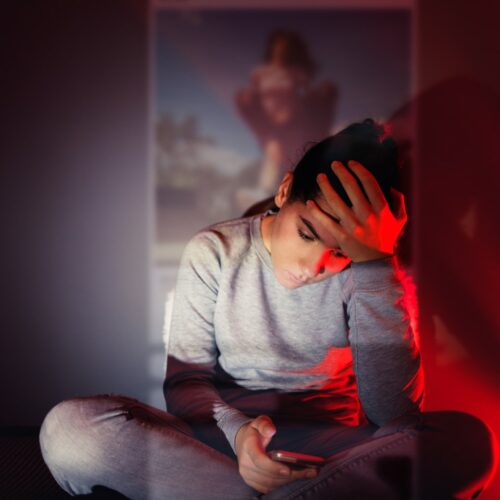Nearly half of adolescent girls on TikTok feel addicted to it or use the platform for longer than they intend, according to a report that looks at social media as a central facet of American girlhood.
While most girls described the effects of social media on people their age as positive, about 1 in 4 who use TikTok, Instagram and Snapchat experience negative social comparisons and feel pressure daily to show the best versions of themselves.
Among those most vulnerable to the downsides of social media were girls with moderate to severe symptoms of depression, who were more likely to say their lives would be better without social media. More of them used social media “almost constantly.” With TikTok, 68 percent said they felt addicted or used it more than intended, compared to 33 percent of girls with no depressive symptoms.
Jacqueline Nesi, co-author and an assistant professor of psychiatry at Brown, also pointed out that three-quarters of girls with moderate to severe depression symptoms who use Instagram report encountering suicide-related content at least monthly. Similarly, 69 percent reported the same issue on TikTok and 64 percent on Snapchat and YouTube.
“That’s a really significant number of girls who are already struggling and then are coming across this type of harmful content online,” she said.
Girls with moderate to severe depressive symptoms were also more likely to encounter helpful mental health resources on the platforms, the report said.
Surprisingly, perhaps, more girls said they felt good or accepting about their bodies — rather than dissatisfied — when using the social platforms, according to the report. Still, nearly 1 in 3 users of TikTok and Instagram felt bad about their bodies at least weekly. For Snapchat, it was 28 percent.
The study’s authors said that they sought to get girls’ voices “front and center” as the nation continues to debate the role of social media in adolescent mental health. The roughly 1,400 girls who participated were demographically representative of the United States. The authors did not examine whether social media is a cause of mental health decline; they focused only on how girls themselves perceive social media and their experiences.
Controversy about the role of social media in the national youth mental health crisis recently has moved into the courts, with an increasing number of school systems filing suit as student well-being has declined, beginning before the coronavirus pandemic.
A report in February by the Centers for Disease Control and Prevention sharpened the focus on the mental health of teen girls, with researchers citing data that showed girls are engulfed in a wave of violence, trauma and sadness.
The new report, released Thursday, showed nearly all girls — 98 percent — had used social media, with 85 percent on YouTube and 73 percent on TikTok. About 60 percent were on Snapchat, Instagram and messaging apps like iMessage, GroupMe or WhatsApp.
“We found that one platform was not that much worse or better than the others,” said Supreet Mann, director of research at Common Sense Media, which advocates for children in the digital age.
Girls weighed in on the benefits of social media, including entertainment, self expression, social connectedness, activism and access to information. Black and Hispanic girls who use YouTube and Instagram were more likely than others to go to the platforms daily for activism.
The downsides: Some received unwanted contact from strangers. Nearly 1 in 4 girls said TikTok interferes with their sleep daily. Other platforms kept girls awake too — 21 percent of those who use Snapchat; 18 percent of those who use Instagram or messaging apps; and 16 percent of those who use You Tube.
Another strain was pressure to respond to friends right away — called “availability stress” — which was more frequent on Snapchat and messaging apps.
The report showed girls were divided in their experiences.
About 1 in 5 girls said they daily focused too much on views, likes, shares and followers, though far more reported doing so less frequently.
Girls who struggle socially in the offline world — being left out or bullied daily, for instance — were three to four times as likely as their peers to report negative experiences online. But in one of many complex findings, they were also more likely to report positive experiences online.
Seven in 10 girls of color said they came across racially affirming material at least monthly on TikTok and Instagram, but nearly half said they encountered racist content or language at least monthly, too.
Similarly, LGBTQ adolescents were twice as likely as their peers to encounter hate speech related to sexual or gender identity. They were also more likely to find connection with others who shared their interests or identities.
“One of the big takeaways is that especially for vulnerable girls … the good is amplified and the bad is amplified, and I think that’s really important when you start to talk about protections,” Mann said.
Common features used by social media companies were also explored, with girls expressing more negative feelings about location-sharing and public accounts. They said video recommendations and private messaging had mostly positive effects on them.
Nearly 4 in 10 had tried to quit a social media platform, or restrict their time on it, for reasons that included spending too much time on a platform, coming across negative content, bullying and concerns about their self image or mental health.
Almost all adolescents had a smartphone they could use to access social media. By age 15, 97 percent did. But even at age 11, 79 percent did.
Girls made some suggestions — more content just for teens, age restrictions that would stop adults from following minors, and time limits for younger users. Other recommendations included easier filtering mechanisms, improved privacy settings and banning problematic users.





